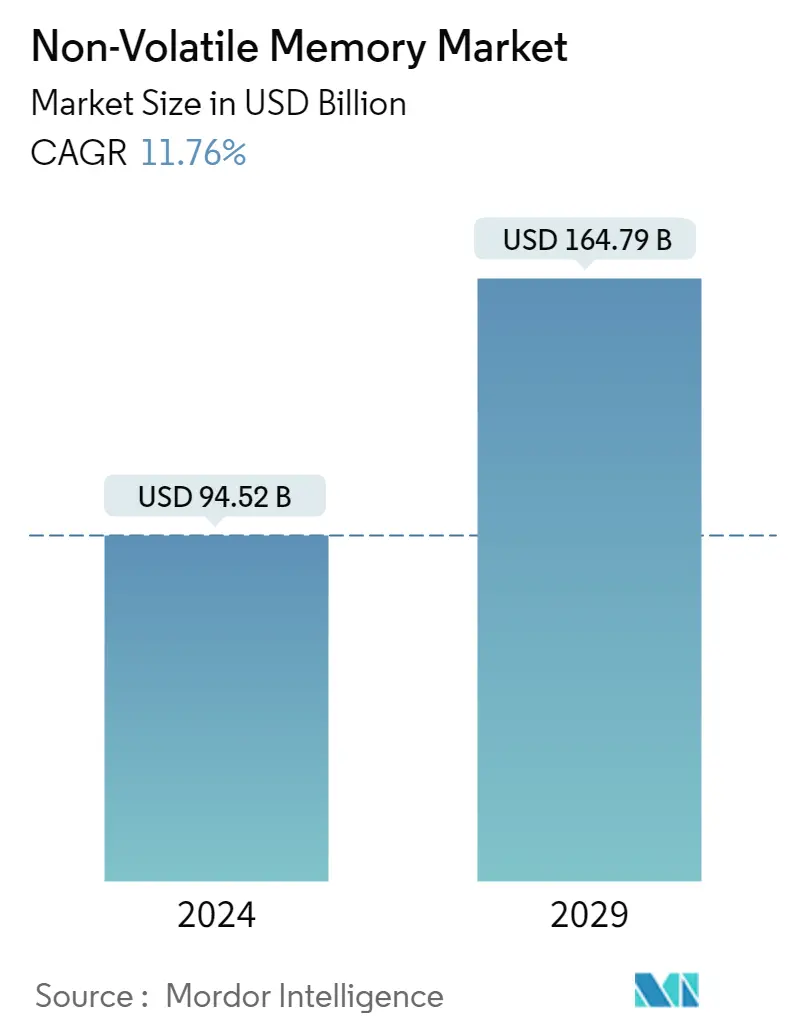Market Size of Non-Volatile Memory Industry

| Study Period | 2019 - 2029 |
| Market Size (2024) | USD 94.52 Billion |
| Market Size (2029) | USD 164.79 Billion |
| CAGR (2024 - 2029) | 11.76 % |
| Fastest Growing Market | Asia Pacific |
| Largest Market | Asia Pacific |
Major Players.webp)
*Disclaimer: Major Players sorted in no particular order |
Need a report that reflects how COVID-19 has impacted this market and its growth?
Non-Volatile Memory Market Analysis
The Non-Volatile Memory Market size is estimated at USD 94.52 billion in 2024, and is expected to reach USD 164.79 billion by 2029, growing at a CAGR of 11.76% during the forecast period (2024-2029).
In the last decade, the growth of the portable systems market attracted the interest of the semiconductor industry in non-volatile memory (NVM) technologies for mass storage applications. Demand for greater efficiency, faster memory access, and low-power consumption drive the NVM market growth.
- In the flourishing consumer electronics industry, users expect their devices to continually become more powerful, provide new functionality with incredible speed, and store more movies, pictures, and music. While flash enabled substantial innovation during the past few decades, a new generation of memory is required as flash hits technology roadblocks, preventing it from scaling much further.
- The adoption of flash memories in consumer electronics due to their low price and power consumption is significant for the market's growth. NVM is used in smartphones and wearable devices to enable more storage and faster memory access.
- The increasing research activities in this space are also driving the market's growth. For instance, in March 2021, Infineon Technologies LLC announced the launch of second-generation non-volatile Static RAMs that are qualified for QML-Q and high-reliability industrial specifications to mainly support non-volatile code storage in harsh environments, including aerospace and industrial applications.
- Similarly, in early 2021, Samsung announced the improvement of its MRAM's MTJ function and advanced its 14 nm process to support its flash-type embedded MRAM designed to increase the write speed and density. In addition, the company targets the IC emerging NVM's application in wearables, microcontrollers, and IoT devices.
- However, troubles with non-volatile memories in the market are often caused by the read/write endurance and data retention characteristics. For instance, Phase-change memories (PCMs) and flash memories are examples of NVM's with limited endurance. These NVM's have little endurance because after undergoing several writing cycles (RESET cycles for PCM, program/erase cycles for flash memory), the memory cells wear out and can no longer reliably store information.
- The COVID-19 outbreak negatively impacted several end-user industries of non-volatile memories, such as the smartphone industry. Spurred demand for server and PC memory for stay-at-home activities, driven by important megatrends like cloud computing, AI, and the IoT, is expected to support the growth of non-volatile memory during the forecast period.
